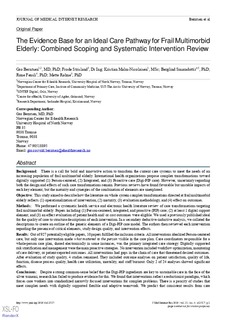| dc.contributor.author | Berntsen, Gro Karine Rosvold | |
| dc.contributor.author | Strisland, Frode | |
| dc.contributor.author | Malm-Nicolaisen, Kristian | |
| dc.contributor.author | Smaradottir, Berglind | |
| dc.contributor.author | Fensli, Rune Werner | |
| dc.contributor.author | Røhne, Mette | |
| dc.date.accessioned | 2019-10-29T10:13:50Z | |
| dc.date.available | 2019-10-29T10:13:50Z | |
| dc.date.created | 2019-06-05T10:33:59Z | |
| dc.date.issued | 2019 | |
| dc.identifier.citation | Journal of Medical Internet Research. 2019, 21 (4), . | nb_NO |
| dc.identifier.issn | 1438-8871 | |
| dc.identifier.uri | http://hdl.handle.net/11250/2625069 | |
| dc.description.abstract | Background: There is a call for bold and innovative action to transform the current care systems to meet the needs of an increasing population of frail multimorbid elderly. International health organizations propose complex transformations toward digitally supported (1) Person-centered, (2) Integrated, and (3) Proactive care (Digi-PIP care). However, uncertainty regarding both the design and effects of such care transformations remain. Previous reviews have found favorable but unstable impacts of each key element, but the maturity and synergies of the combination of elements are unexplored.
Objective: This study aimed to describe how the literature on whole system complex transformations directed at frail multimorbid elderly reflects (1) operationalization of intervention, (2) maturity, (3) evaluation methodology, and (4) effect on outcomes.
Methods: We performed a systematic health service and electronic health literature review of care transformations targeting frail multimorbid elderly. Papers including (1) Person-centered, integrated, and proactive (PIP) care; (2) at least 1 digital support element; and (3) an effect evaluation of patient health and/ or cost outcomes were eligible. We used a previously published ideal for the quality of care to structure descriptions of each intervention. In a secondary deductive-inductive analysis, we collated the descriptions to create an outline of the generic elements of a Digi-PIP care model. The authors then reviewed each intervention regarding the presence of critical elements, study design quality, and intervention effects.
Results: Out of 927 potentially eligible papers, 10 papers fulfilled the inclusion criteria. All interventions idealized Person-centered care, but only one intervention made what mattered to the person visible in the care plan. Care coordinators responsible for a whole-person care plan, shared electronically in some instances, was the primary integrated care strategy. Digitally supported risk stratification and management were the main proactive strategies. No intervention included workflow optimization, monitoring of care delivery, or patient-reported outcomes. All interventions had gaps in the chain of care that threatened desired outcomes. After evaluation of study quality, 4 studies remained. They included outcome analyses on patient satisfaction, quality of life, function, disease process quality, health care utilization, mortality, and staff burnout. Only 2 of 24 analyses showed significant effects.
Conclusions: Despite a strong common-sense belief that the Digi-PIP ingredients are key to sustainable care in the face of the silver tsunami, research has failed to produce evidence for this. We found that interventions reflect a reductionist paradigm, which forces care workers into standardized narrowly focused interventions for complex problems. There is a paucity of studies that meet complex needs with digitally supported flexible and adaptive teamwork. We predict that consistent results from care transformations for frail multimorbid elderly hinges on an individual care pathway, which reflects a synergetic PIP approach enabled by digital support. | nb_NO |
| dc.language.iso | eng | nb_NO |
| dc.rights | Navngivelse 4.0 Internasjonal | * |
| dc.rights.uri | http://creativecommons.org/licenses/by/4.0/deed.no | * |
| dc.title | The Evidence Base for an Ideal Care Pathway for Frail Multimorbid Elderly: Combined Scoping and Systematic Intervention Review | nb_NO |
| dc.type | Journal article | nb_NO |
| dc.type | Peer reviewed | nb_NO |
| dc.description.version | publishedVersion | nb_NO |
| dc.rights.holder | ©Gro Berntsen, Frode Strisland, Kristian Malm-Nicolaisen, Berglind Smaradottir, Rune Fensli, Mette Røhne. Originally published in the Journal of Medical Internet Research (http://www.jmir.org), 22.04.2019. This is an open-access article distributed under the terms of the Creative Commons Attribution License (https://creativecommons.org/licenses/by/4.0/), which permits unrestricted use, distribution, and reproduction in any medium, provided the original work, first published in the Journal of Medical Internet Research, is properly cited. The complete bibliographic information, a link to the original publication on http://www.jmir.org/, as well as this copyright and license information must be included | nb_NO |
| dc.source.pagenumber | 16 | nb_NO |
| dc.source.volume | 21 | nb_NO |
| dc.source.journal | Journal of Medical Internet Research | nb_NO |
| dc.source.issue | 4 | nb_NO |
| dc.identifier.doi | 10.2196/12517 | |
| dc.identifier.cristin | 1702871 | |
| cristin.unitcode | 7401,90,33,0 | |
| cristin.unitname | Smart Sensor Systems | |
| cristin.ispublished | true | |
| cristin.fulltext | original | |
| cristin.qualitycode | 2 | |

